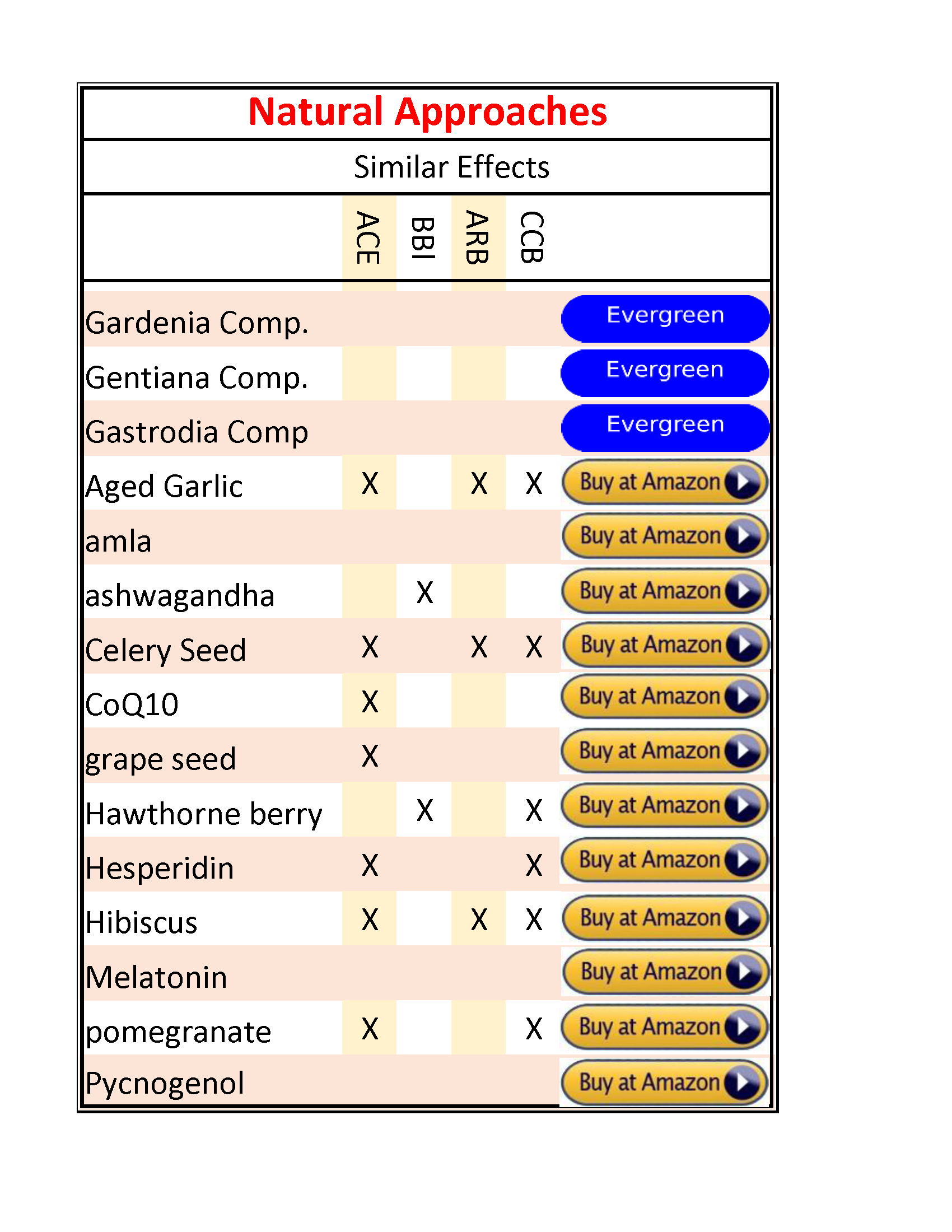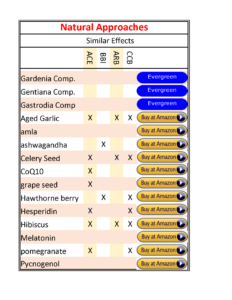To reduce high blood pressure, ACE inhibitors, ARBs, CCBs, and thiazide diuretics are the usual first-line treatments in most guidelines. Natural supplements are available to normalize blood pressure. If you decide to try natural approaches do not stop your pharmaceuticals abruptly! Herbal approaches and TCM formulas may require 1-3 months for effectiveness, as they are treating underlying conditions.


[/vision id="7"]
Traditional Chinese Medicine focuses on restoring balance and harmony in the body using a combination of therapies tailored to the individual’s constitution, underlying imbalances, and symptoms.
High systolic BP with high systolic BP and fast heart rate typically (but not always!) represents excessive heat, calling for a formula that clears heat, purges fire and eliminates toxins. Evergreen Gardenia Complex ![]()
If anger, flushed face and throbbing headache are also present, a formula that drains damp-heat from the Liver and the Gallbladder channels, sedates excess fire and nourishes yin may be more appropriate, such as Evergreen Gentiana Complex. ![]()
High systolic BP with low systolic BP and slow heart rate, and symptoms of dizziness, blurred vision, headache, and/or generalized weakness calls for a formula that extinguishes Liver wind, calms Liver yang, clears heat and nourishes Liver and Kidney yin. Evergreen Gastrodia Complex ![]()
Note: Herbal approaches and TCM formulas may require 1-3 months for effectiveness, as they are treating underlying conditions.
How to use natural supplements
I have listed the most effective supplements above, with links to Amazon. I encourage you to do your own research using an AI program or research engines at PubMed (the national library of medicine) and Google Scholar.
Start with one or more supplements showing a similar mechanism of action (drug class) as your prescribed medication, if your current meds are effective. With my patients, I select a top supplement in 2 or more classes to increase response. I have included an Amazon link chosen for the best purity, dosage and price, and available on Prime.
Unsure what to order? Please call us, we can help! Call a CHS healthcare Professional at 714-886-9026 for guidance.
Common Causes of Hypertension
It used to be believed that over 90% of cases of hypertension were idiopathic, with no known cause. Science has made rapid advances in this field, and we now know that hypertension can be caused by a number of conditions, most of which are treatable. The most commonly considered causes of hypertension are:
- Diabetes: Diabetes can damage the kidneys and cause hypertension.
- Thyroid Disorders: This condition occurs when the thyroid gland doesn’t produce enough (or too much) thyroid hormone, which can cause hypertension. Hypothyroidism may have various causes, including inflammation, surgery, radiation treatment, certain medications or pituitary problems. Hyperthyroidism similarly has multiple causes.
- Sleep apnea: In this condition, often marked by severe snoring, breathing repeatedly stops and starts during sleep, meaning you don’t get enough oxygen. Not getting enough oxygen may damage the lining of the blood vessel walls, which may make your blood vessels less effective in regulating your blood pressure.
- Obesity: As you gain weight, the amount of blood circulating through your body increases. This puts added pressure on your artery walls, increasing your blood pressure. In addition, excess weight often is associated with an increase in heart rate and a reduction in the capacity of your blood vessels to transport blood. All of these factors can increase blood pressure.
- Medications and supplements: Various prescription medications — from pain relievers to antidepressants and drugs used after organ transplants — can cause or aggravate high blood pressure in some people. Birth control pills, decongestants and certain herbal supplements, including ginseng and St. John’s wort, may have the same effect. Many illicit drugs, such as cocaine and methamphetamine, also cause hypertension.
- Viruses: Current research has uncovered a strong link between certain viruses and hypertension. Coxsackievirus has been shown to cause cardiac inflammation and tissue death. Cytomegalovirus, the same virus that causes mononucleosis, may be a cause hypertension and atherosclerosis. CMV infects endothelial cells and causes them to secrete renin and proinflammatory cytokines, raising blood pressure. HIV may result in hypertension.
- Bacterial infections: Including urinary tract infections. Fungal and mold infections such as Stachybotrys chartum
- Autoimmune diseases: Including Goodpasture syndrome, lupus and others.
- Nutritional deficiencies: Including Vitamin D, potassium, sodium, magnesium and others.
- Food allergies and hypersensitivities
- Atherosclerosis: Atherosclerosis is the buildup of fatty deposits called plaque on the inside walls of arteries. Arteries are blood vessels that carry oxygen and blood to the heart, brain, and other parts of the body. As plaque builds up in an artery, the artery gradually narrows and can become clogged. As an artery becomes more and more narrowed, less blood can flow through.
- PCOS: Polycystic ovary syndrome is characterized by presence of multiple cysts on the ovaries, oligomenorrhea or amenorrhea, anovulation and regularly associated with excessive amounts of body hair (hirsuitism), excessive body weight, infertility, insulin resistance and hypertension.
- Stress: Stress-Induced Hypertension: Stress-induced hypertension is high blood pressure associated with physical or emotional stress.
- Conn’s syndrome: Overproduction of aldosterone, a hormone produced in the adrenal glands. This causes an increase in sodium and water retention and loss of potassium. This is the leading cause of secondary hypertension. Symptoms include high sodium and low potassium levels, decreased renin release, muscle cramps and weakness, headaches, fatigue, and excess urination (especially at night). Note that these symptoms are common to other medical conditions.
- Cushing’s syndrome: A hormone disorder caused by high levels of cortisol (hypercortisolism) in the blood. This can be caused by taking glucocorticoid drugs, or by tumors that produce cortisol or adrenocorticotropic hormone (ACTH). Cushing’s disease refers to one specific cause, a tumor (adenoma) in the pituitary gland that produces large amounts of ACTH, which in turn elevates cortisol. Symptoms include rapid weight gain (particularly in the face and torso), growth of fat pads along the collar bone and back of neck, excessive sweating, dilation of capillaries, thinning of skin, easy bruising, muscle weakness, male pattern facial hair growth, baldness, hypercalcemia, insomnia, reduced libido, impotence, menstrual irregularities, depression, anxiety, hypertension, insulin resistance, joint pain and osteoporosis.
- Hyperparathyroidism: The parathyroid glands regulate levels of calcium and phosphorus in your body. If the glands secrete too much parathyroid hormone, the amount of calcium in your blood rises — which triggers a rise in blood pressure.
- Pheochromocytoma: A rare tumor of the adrenal gland that causes too much release of epinephrine and norepinephrine. Less than 10% of such tumors are cancerous. Symptoms include abdominal and chest pain, flushing, increased appetite, irritability, nervousness, palpitations, rapid heart rate, headache, sweating, hand tremor, high blood pressure, and sleeping difficulty.
- Renal artery stenosis: A narrowing of the renal artery, most often caused by atherosclerosis or fibromuscular dysplasia ( a rare disorder). Deterioration in renal function may develop if both kidneys are poorly supplied, resulting in treatment resistant hypertension and eventual kidney failure.
- Glomerular disease: Your kidneys filter waste and sodium using microscopic filters called glomeruli. Swelling of these filters is called glomerulonephritis. If the swollen glomeruli can’t work normally, you may develop high blood pressure.
- Hydronephrosis: In this condition, certain parts of one or both kidneys become plugged due to kidney stones, a tumor or other reasons. This blocks urine flow and raises blood pressure. Some blockages resolve without treatment, but others require drainage or surgery.
- Tyrosinemia: A rare genetic metabolic disorder characterized by a deficiency of particular enzymes which prevents the breakdown of tyrosine which then builds up in the liver.
- Many genetically induced diseases
It is important to consider the CAUSES of hypertension. Subtle symptoms that you may be aware of may hold the keys to finding the causes of your hypertension.
How to measure blood pressure using a sphygmomanometer: The cuff is ‘pumped- up’ to a pressure of 180mmHg, compressing the brachial artery hence causing the artery to collapse once the systolic pressure (the maximum pressure exerted by the blood against the wall of the brachial artery when the heart beats) has been exceeded. At the point where the pressure of the cuff is greater then the systolic pressure, the artery has collapsed thus, there is no flow of blood through the brachial artery. The valve on the pump is loosened slowly to allow the pressure of the sphygmomanometer cuff to decrease. Once the systolic pressure is reached (approximately 120mmHg in the ‘normal’ case), the brachial artery opens causing volatile blood flow, which cause vibrations against the artery walls. These noises are called Korotkoff sounds (named after their discoverer) and can be heard through a stethoscope as the pressure exerted onto the brachial artery falls. The blood flow through the brachial artery increases steadily, until the pressure of the sphygmomanometer cuff falls below the diastolic pressure (the pressure between successive heart beats, the low pressure), approximately 80mmHg. This is the point where the blood flow through the artery is laminar. The Korotkoff sounds The Korotkoff sounds are the sounds heard through the stethoscope as the pressure cuff deflates. The sounds are first heard when the cuff pressure equals the systolic pressure, and cease to be heard once the cuff has deflated past the diastolic pressure. It is generally accepted that there are five phases of Korotkoff sounds. Each phase is characterized by the volume and quality of sound heard. The figure below illustrates these phases. In this example, the systolic and diastolic pressures are 120mmHg and 80mmHg respectively. The Korotkoff sounds Phase 1: With the pressure cuff inflated to beyond the systolic pressure, the artery is completely occluded and no blood can flow through it. Consequently, no sounds are heard above the systolic pressure. At the point where cuff pressure equals the systolic pressure, a sharp tapping sound is heard. We recall that the blood pressure oscillates between systolic and diastolic pressure. At systolic, the pressure is great enough to force the artery walls open and for blood to spurt through. As the pressure dips to diastolic, however, the artery walls bang shut again. It is the closing shut of the artery walls that results in the tapping sound. The Korotkoff sounds Phase 2: This phase is characterized by a swishing sound, caused by the swirling currents in the blood as the flow through the artery increases. Sometimes, if the cuff is deflated too slowly, the sounds vanish temporarily. This happens when the blood vessels beneath the cuff become congested, and is often a sign of hypertension. The congestion eventually clears, and sounds resume. The intervening period is called the auscultatory gap. Korotkoff sounds Phase 3: In this phase, there is a resumption of crisp tapping sounds, similar to those heard in phase 1. At this stage, the increased flow of blood is pounding against the artery walls. Korotkoff sounds Phase 4: At this point, there is an abrupt muffling of sound. The blood flow is becoming less turbulent. Some medical practitioners choose to record this point as the diastolic pressure. Korotkoff sounds Phase 5: This is the point at which sounds cease to be heard all together. The blood flow has returned to normal and is now laminar. The pressure cuff is deflated entirely and removed.
